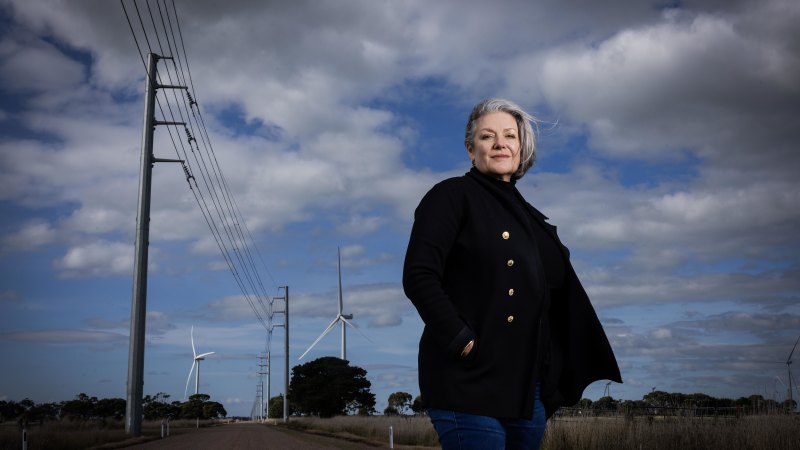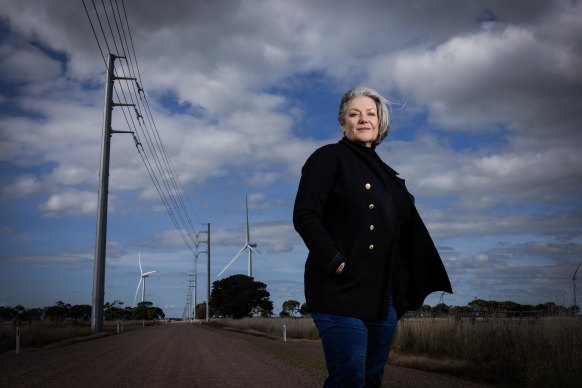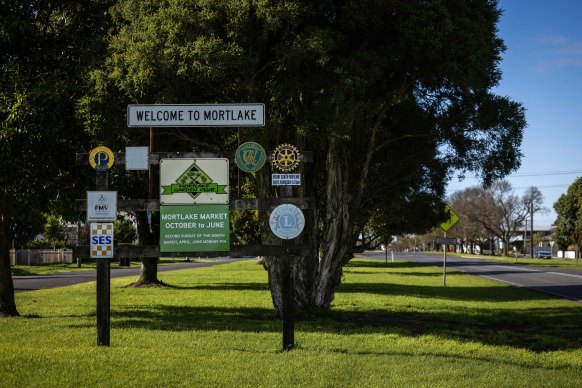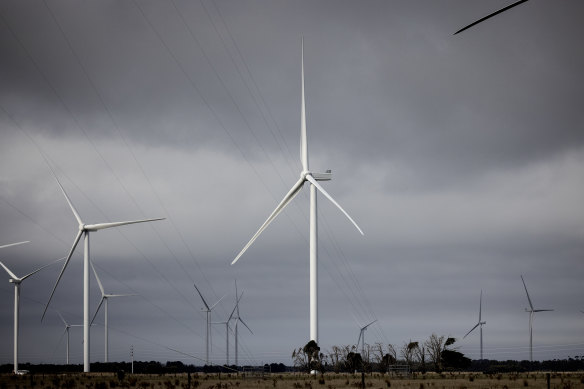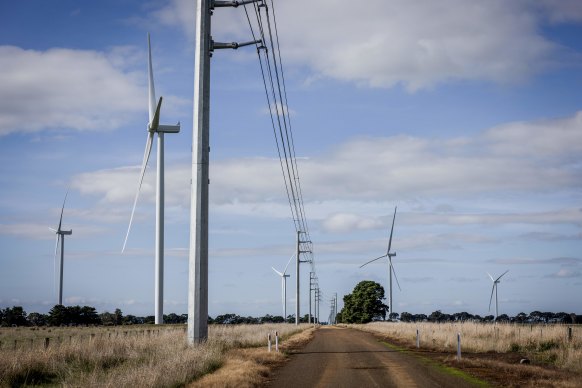Save articles for later
Add articles to your saved list and come back to them any time.
Key points
- A council is western Victoria is calling for new transmission lines to put underground.
- Hundreds of turbines have been built in the Moyne Shire with more to come.
- Moyne Shire says its communities should share in more of the financial benefits from renewables.
The small south-west Victorian town of Mortlake is slowly being surrounded by wind turbines that tower above prime cattle grazing land.
On its outskirts, new power lines supply renewable energy to the state’s electricity grid, crossing over existing wires that have been there for decades.
Mayor Karen Foster says Moyne Shire residents carry a disproportionate burden of towering power infrastructure.Credit: Nicole Clearly
Moyne Shire, which takes in Mortlake, north of Warrnambool, already hosts at least six wind farms with more than 300 turbines in total. More turbines are under construction or proposed.
Moyne Shire Mayor Karen Foster said the wind farms and their accompanying power lines were forming a ring around Mortlake and the wires were leaving a prominent mark on the landscape.
“It’s aerial spaghetti,” Foster said.
The shire is now calling for the introduction of rules making it mandatory for new power lines to be placed underground or co-located with existing lines wherever possible.
Moyne Shire moved a motion at last month’s Municipal Association of Victoria state council meeting calling for the introduction of its proposed reforms to renewable energy infrastructure, and gained the support of almost all Victoria’s councils. The shire wants the state government to back its proposed changes.
Communities across the state have also been fighting for major transmission lines to go underground, including the 190-kilometre Western Renewables Link, proposed to run from Sydenham in north-west Melbourne to Bulgana in western Victoria, and the VNI-West project from Bulgana across the Murray River north of Kerang and into NSW.
Foster said her council supported renewables, but Moyne residents carried a disproportionate burden from the towering power infrastructure concentrated in their communities.
“It’s an industrialisation of the landscape,” she said.
The entrance to the town of Mortlake in Victoria’s south-west.Credit: Nicole Cleary
Last year, Moyne Shire urged the state government to pause the issuing of wind farm planning permits until a range of conditions were met, including five-kilometre buffer zones from towns, an assessment to ensure agricultural land was not impacted, and better processes to protect native wildlife.
Foster said wind power generators – many of which are run by multinational corporations – should ensure communities shared in the financial benefits from renewable power generation.
She said some generators provided free electricity to surrounding communities, but others were far less generous.
“We’re really keen to see the government implement some standards or benchmarks about what constitutes good community investment,” she said.
Wind power generators generally compensate landowners hosting turbines on their properties, but this can create tensions when neighbours miss out.
Monash Energy Institute director Ariel Liebman said cost was a major deterrent for power generators to put transmission infrastructure underground because doing so could be several times the price of overhead wires.
Liebman said regulations for the electricity system were designed for a bygone era and were failing to keep up with the increasing number of energy producers wanting to come online.
Victoria has a target of being 95 per cent reliant on renewable energy by 2035.
Acciona Energia agreed to put 15 kilometres of transmission lines underground from its Mortlake South Wind Farm in response to community concerns.
Wind turbines near Mortlake. Credit: Nicole Cleary
The wind farm is set to begin operating this year with 35 turbines generating the equivalent energy to power 117,000 households.
Acciona engineering and construction director Daniel Belton said putting the lines underground was the most appropriate solution for the company’s Mortlake South project.
“While a more expensive and technically difficult solution, it was a good outcome for the community and its unique circumstances,” he said.
The Mount Fyans Wind Farm, proposed for five kilometres from Mortlake, is undergoing a planning panel process to help determine whether it should receive a permit.
It would have 81 turbines and 19 kilometres of overhead transmission lines.
The company proposing to deliver the project, Woolnorth Wind Farm Holding, did not respond to questions from The Sunday Age.
Resident Nina Thomas, who splits her time between Mortlake and Ballarat, said she feared the proliferation of wind farms would prevent aerial firefighting operations in the case of a bushfire.
Communities in bushfire prone areas have long pushed for power lines to be buried underground, which was a recommendation from the Black Saturday bushfires royal commission.
Thomas said the Mortlake community also feared the Mount Fyans project could damage wildlife, including native birds, during construction and operation.
Moyne Shire is pushing for renewable energy transmission lines to be put underground wherever possible. Credit: Nicole Cleary
“It should be thrown out,” Thomas said. “The sheer number of turbines in one area is excessive.”
Thomas said powerlines from the Dundonnell wind farm run along the northern boundary of her family’s property, and more wires would be erected alongside them if the Mount Fyans project proceeds.
Renewables company Wind Prospect is working to deliver two projects in Moyne Shire: Willatook Wind Farm and Hexham Wind Farm.
Wind Prospect managing director Ben Purcell said all cabling would be underground for the Willatook project except for 300 metres of overhead transmission lines.
He said the need for overhead high voltage lines at the Hexham project had been avoided because the company proposed to build a new terminal station that would join an existing transmission line.
However, Purcell said any overhead distribution powerlines would be located within land hosting wind farm infrastructure.
The state government said through a spokeswoman it was reforming the way transmission infrastructure was planned and developed so farmers, communities and traditional owners had more say and received direct financial benefits.
She said plans for new projects were subject to thorough assessments that considered the cumulative effect of numerous facilities in the same region.
Get to the heart of what’s happening with climate change and the environment. Our fortnightly Environment newsletter brings you the news, the issues and the solutions. Sign up here.
Most Viewed in National
From our partners
Source: Read Full Article
